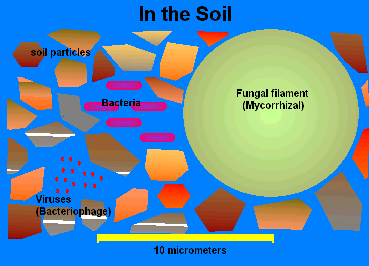




Rainforest
Overview
The tropical rainforests are the richest places in the world
in terms of biodiversity.
A larger variety of animals and plants live here than anywhere else.
The same is true in microbiological terms as
well. As with the animals and plants of the rainforest,
most have never been studied scientifically. They do not even have
scientific names!
Discoveries of new living species are being made all the time by rainforest researchers. Many of the new creatures and plants look interesting and their behavior and lifestyles are fascinating, so they deserve to be preserved and cared for if only for this reason. But rainforest organisms have also been found to possess other amazing properties, that are of potential benefit to mankind. Rubber, medical products and treatments, food-stuffs such as potatoes, chocolate and spices all originate from the rainforests. New discoveries are being made regularly.
The microorganisms are at the bottom of the food chain. So what types of microbes inhabit the rainforest?




The rainforests are home to an enormous range of fungi, protists, algae and bacteria. Many diseases also originate in the rainforests, caused not only by bacteria and viruses, but also by protists. These include some of the most dangerous and frightening - malaria, yellow fever, ebola and HIV, for instance.
Where
the microbes live
Generally, microbes are found in the lower levels of the
rainforest near the ground. The moss layer that grows in trees and
exposed rocks, shade-tolerant mosses, lichens and fungi.
Below this is the litter layer which consists of dead vegetation (leaves,
branches, twigs), dead animals (mostly insects) and feces, though this
is in small quantities compared with the other matter. Under
this is a humus layer, where worms and other
invertebrate animals feed and turn over the matter. Also here
are billions of bacteria and micro fungi
that decompose the litter (detritus) and recycle its nutrients for the
community. This layer blends into the soil layer, which consists
of inorganic clays, sand, or rock. Overall the organically
active humus layer is just a few centimeters at most. Rainforest
bacteria and fungi are extremely efficient workers!

To summarize the microbe activity in the rainforest:
- bacteria and virus (bacteriophage) live in the humus and soil
- bacteria live in water - ponds, streams and rivers
- fungi and molds live on dead matter - animals, wood and other plant remains - and underground
- protists live in water, on plants and animals and in the soil
- bacteria and viruses live in animals and plants
Amazon
life
Rainforest
classroom activities from Australia
Centre
for Global Environmental Education
Teaching
Tropical Rainforest Biology
Sustainable
development in Forestry
Jason
Expedition to the Rainforest
Significance
of Soil Microbiology
Rainforest
Floor
Soil
Biological Communities
Go
to
Home
| Space Station
| Mars | Rainforest
© 1999 Satellite Events Enterprises Inc.
